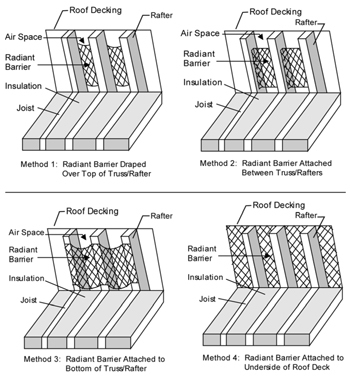Radiant Barriers and Title 24
A radiant barrier is a reflective material located in an attic beneath the roof deck that reduces radiant heat transfer caused by solar heat gain in the roof. Radiant barriers reduce the radiant gain to air distribution ducts and insulation located below the radiant barrier. The Title 24 prescriptive compliance approach requires a radiant barrier in climate zones with significant cooling loads (zones 2-15). The performance approach does not require a radiant barrier in any climate zone.
The most common way of installing a radiant barrier is to use roof sheathing that has a radiant barrier bonded to it in the factory. Oriented strand board (OSB) is the most common material available with a factory-applied radiant barrier. The sheathing is installed with the radiant barrier (shiny side) facing down toward the attic space.
Other methods of installing a Title 24 compliant radiant barrier include:
- Draped over the truss/rafter (the top chords) before the upper roof decking is installed.
- Spanning between the truss/rafters (top chords) and secured (stapled) to each side.
- Secured (stapled) to the bottom surface of the truss/rafter (top chord). A minimum air space shall be maintained between thetop surface of the radiant barrier and roof decking of not less than 1.5 inches at the center of the truss/rafter span.
- Attached (laminated) directly to the underside of the roof decking. The radiant barrier shall be laminated and perforated by the manufacturer to allow moisture/vapor transfer through the roof deck.
The radiant barrier shall be installed to cover all gable end walls and other vertical surfaces in the attic. The attic shall be ventilated to:
- Conform to the radiant barrier manufacturer's instructions.
- Provide a minimum free ventilation area of not less than one square foot of vent area for each 150 sf of attic floor area.
- Provide no less than 30 percent upper vents.
Ridge vents or gable end vents are recommended to achieve the best performance. The material should be cut to allow for full airflow to the venting.
The radiant barrier (except for radiant barriers laminated directly to the roof deck) shall be installed to have a minimum gap of 3.5 inches between the bottom of the radiant barrier and the top of the ceiling insulation to allow ventilation air to flow between the roof decking and the top surface of the radiant barrier, and have a minimum of six (6) inches (measured horizontally) left at the roof peak to allow hot air to escape from the air space between the roof decking and the top surface of the radiant barrier.
When installed in enclosed rafter spaces where ceilings are applied directly to the underside of roof rafters, a minimum air space of 1 inch shall be provided between the radiant barrier and the top of the ceiling insulation, and ventilation shall be provided for every rafter space. Vents shall be provided at both the upper and lower ends of the enclosed rafter space.
(Excerpted from the CEC Title 24 Residential Compliance Manual)

